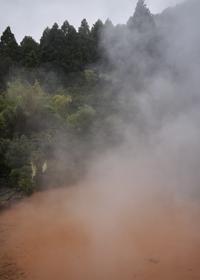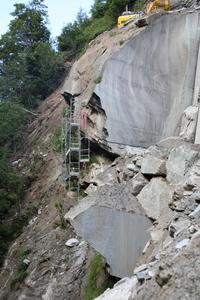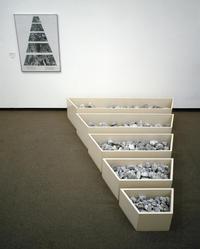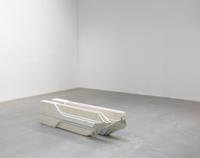Stone
‘To discover is to reveal by excavation’,
Robert Macfarlane in Underworld, 2019
It all comes down to this: stone is a piece of rock made usable for men – a portion of rock used as building material.
Rocks can be defined as extensive mineral bodies, composed of one or more minerals in varying proportions. Minerals are the building stones of the earth’s crust. They are stony mixtures of one or more elements (from copper, to iron, sulphur, gypsum and carbon), that man has found in the earth’s surface and its rocks. Running to a depth from a minimum of four kilometres under the ocean to one hundred kilometres under the continents, the lithosphere constituting the ‘crust’ is made up of rock produced by solidified magma. The three main types of rock are igneous, sedimentary and metamorphic, and all result from a continuous geological cycle of being formed, worn down into pieces, and then formed again.
MATERIAL GESTURE AND SITE
In autumn 2019, we travelled to Japan’s southern volcanic island, Kyushu. Our aim with the travel was to explore site not in the context we usually consider – as in the view, the vegetation or the relationship to a built environment – but rather, site from a geological perspective; how the landscape is formed, what the ground consists of, and how it is changing. We explored the geology of Kyushu: the soil, sand, stone, minerals, lava and ash, as well as the crust, faults, cracks, hills and craters. We studied the processes (the gestures of the volcano, so to speak) that have shaped the landscape as it is and that will continue to change it in the future.
The projects that were developed in the design studio were based on the materials and the volcanic processes that are present on the island, which were used or transformed to design a space for that site: a space that is born from the site in its material constituents and that is constructed on that site, in harmony or contrast, to the previous gestures that have formed the geology of the place.
With our work for Kyushu, I realised that with material gesture, we always relate to a site. Looking at any building material, ‘a’ site is always present, namely, the place where we source our material from. Our mines, excavations and quarries are the source for building. In order to build, we mine. Therefore, we work on at least two sites: the place of sourcing our raw material and the place of building construction. All places in between, where the material is worked on and transformed, could be considered as sites as well.
Vernacular architecture is characterised by the presence of the site of raw material and the site of the building construction that is made in its vicinity: from the clay buildings in Mali or Yemen, to the travertine used in Rome, the coral stone material used traditionally in the Gulf or the gneiss stone used in the village of Vals.
The importance of sourcing the raw material brought architects and sculptors to the ‘other’ site. Bernini had built a house next to one of the travertine quarries in Tivoli (close to Rome) to supervise the selection of stone with which he built most of his architecture and sculptures. He contributed to a period spanning more than twenty centuries, in which travertine is the construction material for many monumental buildings in Rome, such as the Colosseum. Michelangelo, until his death in 1564, repeatedly spent many months in the marble quarries of Carrara, in order to secure the best sections of stone for his sculptures. He even had a road built to transport the gigantic blocks, which ended near what is today the bathing resort of Forte dei Marmi.
Peter Zumthor wrote in his recollections on his project for Vals, ‘We walked around the village and, suddenly, everywhere there were boulders, big and small walls, loosely stacked rough plates, split material; we saw quarries of different sizes, slopes cut away, and rock formations’. In one sentence, Zumthor links the village, the building, the quarry and the landscape with its rock formations, all as sites with the same material presence. He shows the intrinsic links between the different sites of the gneiss stone.
Architecture made with locally sourced material has a strong site sensitivity that is generally considered to be ‘good’ and often relates nowadays to preservation and a sustainable idea of building. To preserve places with vernacular architecture, traditionally used local material is prescribed by authorities for new construction, as is the case in Vals for the use of gneiss stone. Contradictory to the wish for the use of local material, the quarries and mines for sourcing the raw material are seen as harmful to the environment. The ‘other’ site, necessary for our building, is often less wished-for, hence laws that require reclamation of the mountain landscape after sourcing the stone.
SITE AND NON-SITE
Nowadays, in our modern and industrialised world, and also throughout history, material has been displaced and disconnected from where it is sourced. Stones have been collected from all around the world to showcase the wealth and stature of the collector. Material has been shipped and traded for its specific qualities worldwide for thousands of years – think of the silk roads that began during the Han Dynasty in China and reached as far as Europe. Mostly with modernity, the sourcing of materials has increased significantly to keep up with the demands of building construction and other production.
The material sourcing and displacement in industrial quantities, therefore showcasing our current age, was an important influence in the work of the American artist Robert Smithson. He began, in the sixties, exploring industrial areas around New Jersey (where he was from) and was fascinated by the sight of dumper trucks excavating tons of earth and rock that he described as the ‘equivalents of the monuments of antiquity’. This resulted in a series of works titled ‘Non-sites’ in which earth and rocks collected from a specific area were installed as sculptures in exhibitions.
The Non-sites were presented as simple containers of painted or galvanised steel that contained the raw material, such as rocks, gravel and salt, collected from distant sites. Next to this collection of raw material, maps were shown indicating the mines, excavations or quarries from which the materials had been taken. The maps were crucial as they directed the viewer to the original site and established the ‘dialectic’ between site and non-site. Smithson noted in his own comparison that a site is about scattered information (‘The site is a place you can visit and it involves travel as an aspect too’) and a non-site is about contained information.
The relationship that Smithson established between site and non-site introduced an understanding of process, the passage between the two locations, and threw emphasis on time and duration. The ‘in-betweenness’ destabilises our understanding of site as one place and brings forward multiple places, with links to each other brought forward by the presence of the material. Much like the recollection of Zumthor, the material presence is in multiple sites from the rock formation, the quarry, the building and the village. They all build up to an understanding of all sites in which the material is a constant.
The key to the idea of Non-sites is the displacement; how the meaning and value of an object is changed by removal to another site. The focus of this semester is to take all sites into consideration when working with the material of stone. Stone can be understood here as a metaphor for site. We will study the traces in the material in its geological formation, traces in the ways of quarrying it, traces in the displacement and traces in its assembling and finishing. We are interested in the dialectics of change that is brought forward by the displacement of material through its different sites and how all of these ‘traces’ can be used and transformed in our way of working with it.
Anne Holtrop



